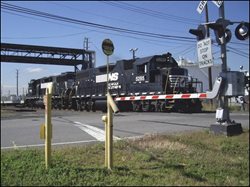This study addresses th e impacts of increased freight rail traffic along the region’s major freight rail lines. The NJTPA’s Regional Transportation Plan (Access and Mobility 2030) projects that freight rail traffic in the region will double over the next 25 years. This traffic will result in increased delays at grade crossings, and raises issues of safety and quality of life in those communities where these crossings are located. The study systematically assessed these impacts and identified potential remedies to improve traffic flow and increase safety at critical locations along major freight rail lines. The projected growth in rail traffic will be experienced over all sectors of railroad business as rising fuel prices increase the demand for more efficient long distance rail services. This study was completed in two phases.
e impacts of increased freight rail traffic along the region’s major freight rail lines. The NJTPA’s Regional Transportation Plan (Access and Mobility 2030) projects that freight rail traffic in the region will double over the next 25 years. This traffic will result in increased delays at grade crossings, and raises issues of safety and quality of life in those communities where these crossings are located. The study systematically assessed these impacts and identified potential remedies to improve traffic flow and increase safety at critical locations along major freight rail lines. The projected growth in rail traffic will be experienced over all sectors of railroad business as rising fuel prices increase the demand for more efficient long distance rail services. This study was completed in two phases.
Freight Rail Grade Crossing Assessment Study Phase II
The NJTPA Board of Trustees has approved an extension of the study to analyze freight rail crossings in northern and central New Jersey with the objective of developing problem statements for the next ten grade crossing locations prioritized in terms of needs in the original study. This work was completed and approved by the NJTPA Board of Trustees on August 24, 2009.
Freight Rail Grade Crossing Report: Phase II Summary—Crossings #6 to #15
Freight Rail Grade Crossing Assessment Study Phase I
To  carry out the study, the NJTPA selected the firm of Jacobs Edwards and Kelcey, supported by Anne Strauss-Wieder, Inc. and Atlantic Rail Services. The study group, accompanied by TAC members, developed a database of rail crossings throughout the region and made this database available to NJTPA staff and other county and state agencies. In all, 64 at-grade freight rail crossings were catalogued, characterized, geocoded, and photographed as a first step in this study. These crossings are along five major freight lines, namely: the Lehigh Valley, West Trenton Line, Chemical Coast, Port Reading Secondary, and the West Shore (River) Line / National Docks.
carry out the study, the NJTPA selected the firm of Jacobs Edwards and Kelcey, supported by Anne Strauss-Wieder, Inc. and Atlantic Rail Services. The study group, accompanied by TAC members, developed a database of rail crossings throughout the region and made this database available to NJTPA staff and other county and state agencies. In all, 64 at-grade freight rail crossings were catalogued, characterized, geocoded, and photographed as a first step in this study. These crossings are along five major freight lines, namely: the Lehigh Valley, West Trenton Line, Chemical Coast, Port Reading Secondary, and the West Shore (River) Line / National Docks.
Data such as vehicular traffic, number of accidents/incidents and duration of delay, surrounding land use, and pedestrian access were analyzed along with forecast rail operating conditions to produce a methodology for prioritizing these crossings. The final product contains strong elements of public outreach, an assessment of various impacts, a prioritized list of the rail crossings experiencing the highest impacts, and a range of strategies and solutions for addressing these impacts. Five of the most impacted crossings were selected for detailed analysis and recommendations. The consultants developed a toolbox so that these approaches could be applied to other crossings in the region as well. This work was completed and approved by the NJTPA Board of Trustees at the September, 2008 meeting.
Freight Rail Grade Crossing Assessment Study—Phase I Report